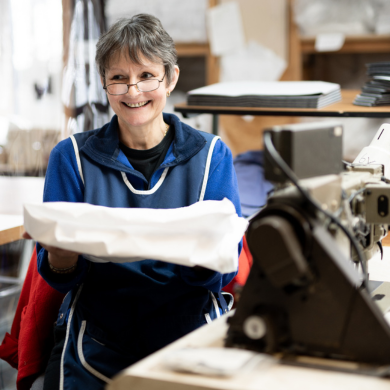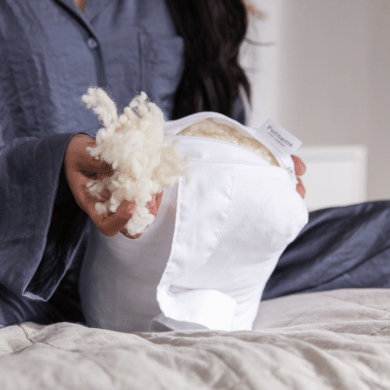
Soulager les douleurs discales du dos en position assise et pendant le sommeil
Souffrir de douleurs discales au dos peut être extrêmement frustrant. Pour beaucoup, c'est une conséquence du mode de vie sédentaire actuel, mais cela peut aussi être le résultat d'un excès d'exercice ou d'un bon vieux « mauvais sort ». La bonne nouvelle ? Avec la bonne approche et les bons produits, vous pouvez trouver un soulagement.
Si vous faites partie des 1 personne sur 3 au Royaume-Uni qui souffrent de douleurs discales dans le dos, nous sommes là pour vous offrir un certain soulagement, ici et maintenant !
Ce guide vous présentera des conseils pratiques pour soulager les douleurs discales du dos lorsque vous êtes assis et que vous dormez, vous aidant ainsi à découvrir une vie plus confortable.
Comprendre les douleurs discales du dos
Anatomie de la colonne vertébrale et des disques intervertébraux
Votre colonne vertébrale est une structure complexe composée de vertèbres, de disques intervertébraux, de nerfs et de tissus de soutien. Les disques intervertébraux sont des coussinets situés entre les vertèbres, qui agissent comme des amortisseurs et permettent la flexibilité et le mouvement. Ces disques ont une couche externe fibreuse et résistante et un noyau interne semblable à du gel. Lorsqu'un problème survient, il est important de traiter le problème immédiatement pour éviter des épisodes récurrents plus douloureux.
Bien qu'il existe de nombreux traitements différents recommandés pour les blessures au dos, il est important de s'assurer que l'environnement de repos approprié est disponible pour permettre à vos muscles et ligaments de récupérer complètement.
Putnams propose une large gamme d'oreillers, notamment des oreillers pour hernie discale, des oreillers compensés pour hernie discale et des oreillers pour hernie cervicale. Tous ces produits offrent un environnement idéal pour la récupération.
Causes courantes des douleurs discales du dos
Les douleurs discales du dos peuvent être causées par divers facteurs, notamment une mauvaise posture, un mode de vie sédentaire, des mouvements brusques et des blessures. Une position assise prolongée et des techniques de levage inappropriées peuvent fatiguer la colonne vertébrale, entraînant une dégénérescence discale ou une hernie.
Comprendre ces causes est essentiel pour prévenir et gérer les douleurs dorsales liées aux disques.
Symptômes et diagnostic
Symptômes typiques des douleurs discales du dos
Les personnes souffrant de douleurs discales au dos ressentent souvent une douleur aiguë ou chronique, des picotements, un engourdissement ou une faiblesse dans la zone touchée. La douleur peut irradier vers d'autres parties du corps, comme les jambes ou les bras, selon le disque affecté.
Importance du diagnostic et du traitement professionnels
Si vous pensez avoir un problème de disque, il est essentiel de consulter un professionnel pour un diagnostic et un traitement. Un professionnel de la santé peut effectuer des examens physiques, des tests d'imagerie et d'autres procédures de diagnostic pour déterminer la cause exacte de votre douleur et recommander des options de traitement appropriées.
Solutions pour soulager les douleurs du disque dorsal
Siège ergonomique et posture appropriée
L’un des moyens les plus efficaces pour soulager les douleurs du dos est d’investir dans des sièges ergonomiques et de maintenir une bonne posture. Les chaises avec support lombaire , hauteur réglable et fonction inclinable peuvent réduire considérablement la tension sur votre colonne vertébrale.
L'utilisation de repose-pieds et des pauses régulières pour s'étirer peuvent également aider. En plus des coussins pour hernies discales et d'une gamme d'autres produits Putnams spécialement conçus, la vie peut être un peu moins douloureuse.
Oreillers et matelas de soutien
Les oreillers et surmatelas de soutien jouent un rôle essentiel dans la gestion des douleurs discales du dos. Les oreillers en mousse à mémoire de forme ou orthopédiques peuvent fournir le soutien nécessaire à votre cou et au bas du dos. De même, un surmatelas pour une hernie discale peut assurer un bon alignement de la colonne vertébrale pendant votre sommeil.
Découvrez la gamme de produits Putnams pour d'excellentes options ici .
" Oreiller de soutien du dos pour litAu début, j'avais l'impression de ne pas pouvoir dormir avec ce coussin, mais je m'y suis vite habituée et, en soutenant mon dos, je dors beaucoup mieux la nuit. Quand je me réveille le matin, je n'ai plus mal au dos." - Jane M
Outils et produits spécifiques pour le soulagement
Oreillers, coussins et surmatelas
Les oreillers spécialisés pour hernie discale, les coussins pour hernies discales et les surmatelas pour hernies discales peuvent offrir un soulagement ciblé des douleurs discales du dos. Des produits comme l' oreiller compensé pour hernie discale et l'oreiller pour hernie cervicale sont conçus pour soutenir votre colonne vertébrale et réduire la pression sur les disques affectés. Ces produits doivent être utilisés en conjonction avec l'assistance médicale guidée de votre médecin généraliste.
L’utilisation d’un coussin pour une hernie discale ou d’un matelas ferme pour une hernie discale peut également faire une différence significative en termes de confort et de soulagement de la douleur.
Caractéristiques et avantages des produits recommandés
Lors de la sélection des produits, recherchez des caractéristiques telles que la construction en mousse à mémoire de forme, la fermeté réglable et la conception ergonomique. Ces caractéristiques garantissent un soutien optimal et une adaptabilité aux besoins de votre corps. Par exemple, le coussin de soutien du dos pour voiture Putnams Duo est doté d'une mousse à mémoire de forme qui épouse la courbe naturelle de votre dos, offrant à la fois confort et stabilité, le coussin parfait pour une hernie discale.
Coussin de soutien dorsal pour voiture Duo - Mousse à mémoire de formeJ'ai acheté ce coussin de soutien pour mon mari pour ses douleurs lombaires récurrentes. En quelques jours, il a remarqué une réelle différence, l'utilisant dans la voiture et à son bureau, à tel point qu'aujourd'hui nous en avons commandé un deuxième à laisser sur son bureau de travail." - Jacqui P
Modifications du mode de vie et exercices
Conseils pratiques pour améliorer la posture
Une mauvaise posture est l’une des principales causes de douleurs discales du dos.
De simples ajustements, comme s'asseoir les pieds à plat sur le sol, garder le dos droit et éviter de s'affaisser, peuvent améliorer considérablement la santé de votre colonne vertébrale. Au travail, utilisez une chaise avec un soutien lombaire adéquat et placez votre écran à hauteur des yeux.
Exercices et étirements simples
L'intégration d'exercices et d'étirements spécifiques dans votre routine quotidienne peut renforcer votre dos et vos muscles abdominaux, réduisant ainsi la tension sur votre colonne vertébrale. Essayez des exercices comme les inclinaisons du bassin, les étirements chat-vache et les postures de yoga douces pour améliorer la souplesse et soutenir votre colonne vertébrale.
La cohérence est essentielle, essayez donc d’effectuer ces exercices quotidiennement.
Yoga pour la santé du dos : Le yoga est une méthode douce mais efficace pour étirer et renforcer les muscles qui entourent votre colonne vertébrale. Des postures comme la posture de l'enfant, le chien tête en bas et la torsion de la colonne vertébrale en décubitus dorsal favorisent la souplesse et la relaxation de la colonne vertébrale. Assister à des cours de yoga ou pratiquer des routines de yoga à la maison peut être une pratique de pleine conscience qui soulage également les tensions.
Pilates pour renforcer le tronc : Le Pilates met l'accent sur le renforcement des muscles centraux, qui soutiennent la colonne vertébrale et peuvent soulager la douleur causée par les problèmes de disques. Des exercices tels que la flexion du bassin, l'étirement de la colonne vertébrale et le cercle des jambes sont bénéfiques pour améliorer la stabilité de la colonne vertébrale. La pratique du Pilates peut conduire à une meilleure posture et à une réduction de la pression sur les disques.
Le Tai Chi pour l'équilibre et la relaxation : Le Tai Chi combine des mouvements lents et réfléchis avec une respiration profonde, favorisant l'équilibre et la relaxation. Cet exercice à faible impact peut améliorer la posture et la souplesse, ce qui en fait un excellent choix pour les personnes souffrant de douleurs discales au dos. La pratique régulière du Tai Chi peut améliorer le bien-être général et aider à gérer la douleur chronique.
À la recherche de conseils et de traitements professionnels
Consultation avec des professionnels de la santé
Bien que les soins personnels et les changements de style de vie soient bénéfiques, il est essentiel de consulter un professionnel de la santé pour obtenir des conseils et un traitement personnalisés.
Les physiothérapeutes , les chiropraticiens et les spécialistes orthopédiques peuvent proposer des interventions ciblées, telles que la méthode McKenzie , la libération myofasciale et l'hydrothérapie, pour gérer et soulager les douleurs discales du dos.
Quand consulter un médecin
Si votre douleur persiste ou s'aggrave malgré les mesures d'auto-soins, il est essentiel de consulter rapidement un médecin. Une intervention rapide peut prévenir d'autres complications et améliorer vos chances de guérison complète.
Votre médecin généraliste ou votre prestataire de soins de santé peut vous guider à travers différentes options de traitement, notamment les médicaments, la physiothérapie et, dans les cas graves, la chirurgie.
Dites adieu aux douleurs discales du dos et retrouvez le confort
Les douleurs discales du dos peuvent être une pathologie difficile et perturbatrice, mais avec les bonnes stratégies, vous pouvez les gérer et même les prévenir efficacement. En comprenant les causes et les symptômes, en investissant dans des solutions ergonomiques, en intégrant des produits de soutien et en vous engageant à modifier votre mode de vie et à faire des exercices, vous pouvez améliorer considérablement la santé de votre colonne vertébrale et votre bien-être général.
N'hésitez pas à consulter des professionnels de la santé pour des conseils personnalisés et des options de traitement.
N'oubliez pas que votre confort et votre productivité valent bien l'effort. Faites le premier pas vers le soulagement de vos douleurs discales du dos dès aujourd'hui. Explorez la gamme de produits Putnams pour le mal de dos , consultez un professionnel de la santé et intégrez les conseils et exercices décrits dans ce guide.
Votre colonne vertébrale vous remerciera.

















Laissez un commentaire